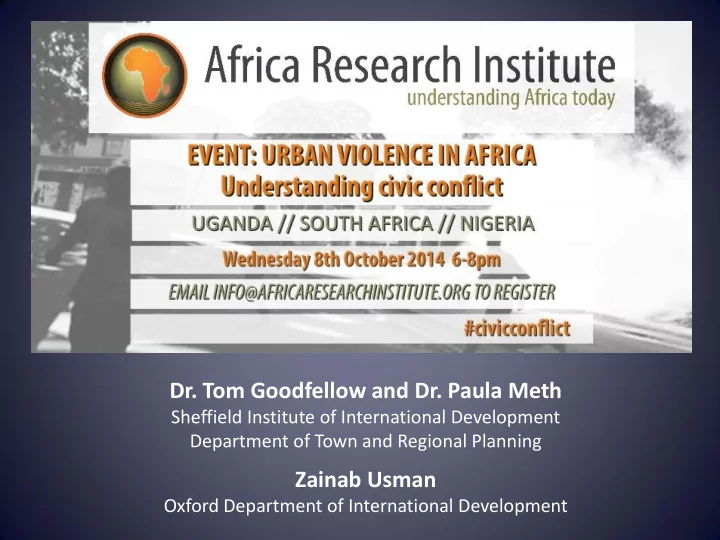

Urban Violence Dr. Tom Goodfellow and Dr. Paula Meth Sheffield Institute of International Development Department of Town and Regional Planning Zainab Usman Oxford Department of International Development
Around three times more people die each year from interpersonal violence (homicides) than from war.
The challenge of urban violence • Are cities inherently violent? • Why are some cities so much more violent than others? • When does urban conflict become violence, and why? • What determines the visibility of violence? 3
Some emerging research themes: • Beyond ‘social’, ‘political’ and ‘criminal’ • From civil to civic conflict? Violence transformations • Role of level of urbanisation, city size and urban growth rate • Contesting the role of youth • Explaining dramatic reductions in urban violence • Critical roles of land, space, gender, employment • Relationship between urban violence & politics: – Governance, party competition, freedom of speech and assembly 4
Changing violence trends in Africa, 1998-2012 Source: ACLED dataset, 2013 5
The politics of violent urban protest in Uganda Tom Goodfellow, University of Sheffield 6
Exit, voice and ‘noise’ in urban Africa 7
Violent conflict events in Kampala, 1998-2011 8
The rise of urban protest in Uganda • Twenty years of relative calm in Kampala up to 2005 2006-9 Riots among ‘idle 2009-10 youth’ due to lack of ‘Buganda riots’; 2011-12 jobs, inconsistent ostensibly about government policy, ‘Walk -to- work’ ethnic issues (but lack of government protests and riots; involving many of the responsiveness ostensibly about same people) electoral issues and inflation 9
‘Parallel participation’ • Marketplace traders resorted to rioting when they realised politicians were playing them and they ‘had no voice’ in relation to the City Council • Emerging norm of civic conflict as a means of participating in urban political process – ‘Like has been the norm, the Activists for Change led by FDC President Kizza Besigye left the venue and within a few seconds the charged youth began hurling stones at the police [and] police responded by firing tear gas 10
Protest and partial democratisation • Unpacking the link between civic violence and ‘hybrid’/ ‘semi - authoritarian’ regimes • An explosive coexistence of the promise of democracy (through the existence of multiple parties and a relatively free media) and the reality of authoritarian repression • Uganda under President Museveni: the master manipulator of democratic process 11
Uses of the legislature in a ‘semi - authoritarian’ regime • Drafting of intentionally contentious laws since multi- party competition was reintroduced in 2005 – Part of a broader strategy to provoke, divide & manipulate opposition in the face of new political environment • Particularly in relation to escalating ethnic tension over the ‘Buganda question’ • Three ‘contentious bills’: – The Land (Amendment) Bill (2007) – The Regional Governments Bill (2009) – The Kampala Capital City Bill (2009) 12
Legal manoeuvres • Deliberately inflaming ethnic tensions by tapping into long-standing (colonial) resentment against Baganda • Divide and rule: sacrificing support among Baganda in order to bolster support among other ethnic groups • The Bills themselves were mostly ‘legal nonsense’ • Tactical use of legislative process: debating, amending, passing & shelving at strategic points in electoral cycle • Timing of these processes to aimed to sanction and divide opposition groups at key moments 13
Feeding urban political instability • All this had a hugely destabilising impact on urban political arena • Protracted legislative debates without meaningful change for the poor: ‘ When you see people running round and sacking shops, burning down police stations it is not because they have been commanded [but] because they think you are going to do nothing more than talking ’ • September 2009 ‘Buganda riots’ – Most violent urban episode since 1986; over 40 people killed (mostly by government) & hundreds injured – Some rioters explicitly referred to these legal debates 14
Beyond the Buganda case: Legal debates fuelling urban violence • Public Order Management Bill – Played important political role as ‘looming threat’ (2009 -13) – In the meantime, the controversial bill fuelled urban protest and exacerbated ‘walk -to- work’ protests of 2011 -12 • ‘ Anti- Homosexuality Bill’ – Draft bill served clear political functions at key points from 2010-2014, both domestically and internationally – Instrumentalization of legal debate over the bill: ‘The longer it takes, the better for Museveni’ (Kapya Kaoma) – In the meantime, there were at least five violent protests directly linked to the bill, several involving fatalities 15
Conclusions • New threats to the ruling party since 2005 have led to new strategies to manipulate democratic institutions • Among these is the debating of contentious laws (which are often not even implemented) as a tool for dividing opposition and controlling political discourse • Whether deliberately or as a side-effect, this has stimulated urban unrest and consequent government crackdowns • Dynamics such as these, and more generally the tactics and strategies employed by authoritarian governments facing pressures to democratise , may partly explain why ‘hybrid’ regimes tend to have high levels of civic conflict 16
Recommend
More recommend